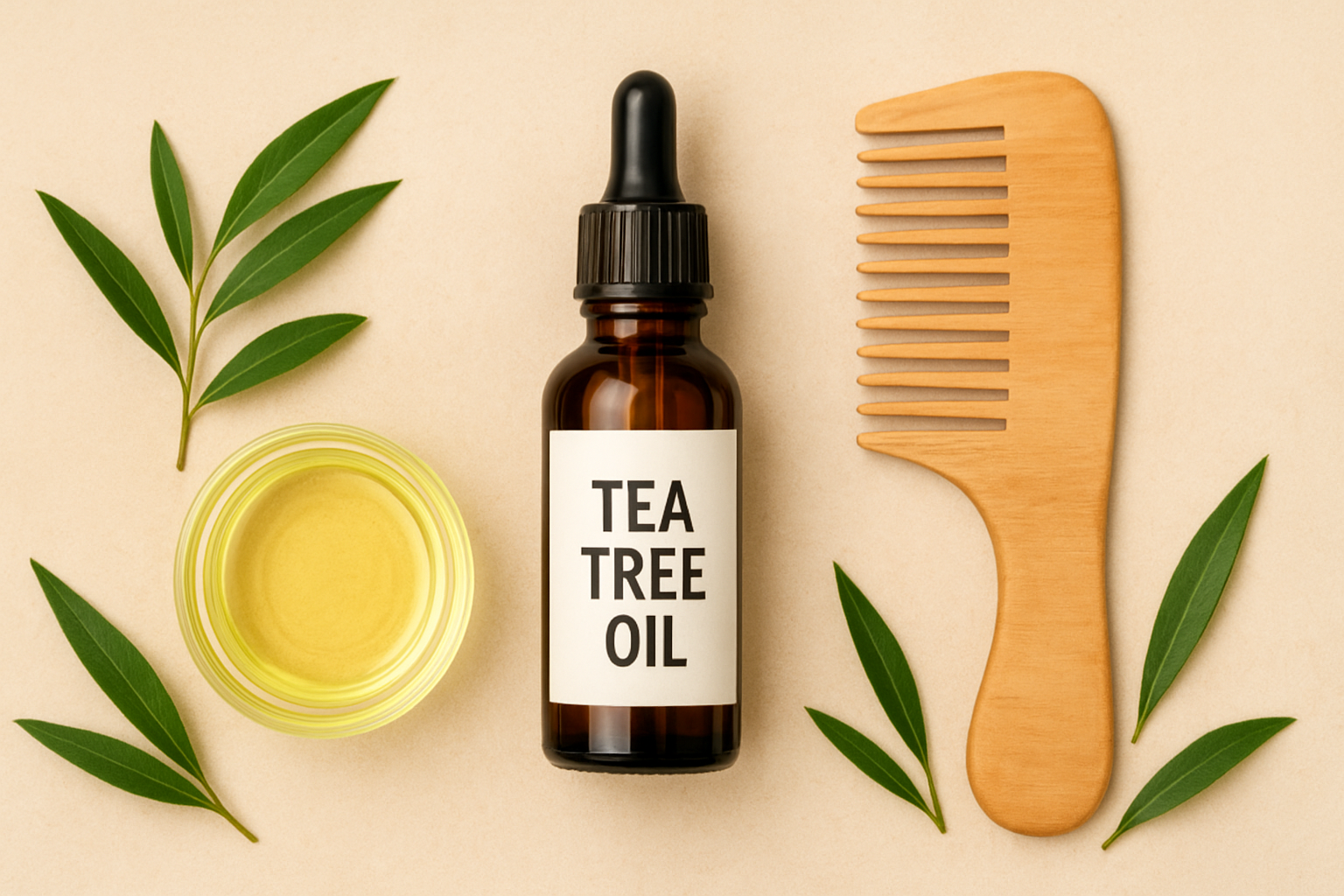Introduction: Nature’s Cleansing Oil for a Healthy Scalp
When your scalp feels itchy, dry, or flaky, your hair can’t thrive. Enter tea tree oil, a time-tested essential oil celebrated in aromatherapy and Ayurvedic-inspired hair care for its cleansing, antifungal, and soothing properties. Extracted from the leaves of Melaleuca alternifolia, this powerful natural oil helps rebalance the scalp’s ecosystem, promoting strong and healthy hair growth.
Tea tree oil isn’t just a beauty trend—it’s a therapeutic ally for scalp health. Research published in the Journal of Dermatological Treatment (2024) found that regular use of tea tree oil shampoos reduced dandruff severity by over 40% within four weeks. Whether your goal is to combat itchiness, dandruff, or scalp buildup, this guide will help you use tea tree oil safely and effectively through aromatherapy practices.
Understanding Tea Tree Oil and Its Benefits for Scalp Health
Before you start applying it, let’s understand why tea tree oil is so effective for your scalp. This essential oil contains terpinen-4-ol, a natural compound known for its antibacterial and antifungal effects. When applied correctly, it helps unclog hair follicles, reduce inflammation, and balance excess oil production.
From an aromatherapy perspective, tea tree oil also helps calm the mind and refresh the senses, reducing stress—a hidden culprit behind scalp issues and hair loss.
Key Benefits of Tea Tree Oil for Hair and Scalp
- Fights Dandruff: Its antifungal properties combat Malassezia, the yeast responsible for dandruff.
- Soothes Itchiness: Reduces irritation caused by dryness or buildup.
- Promotes Hair Growth: Improves blood circulation and follicle health.
- Controls Oil and Buildup: Keeps the scalp clean without stripping natural oils.
- Natural Aromatherapy Boost: Invigorating scent enhances mood and relaxation during scalp massages.
How to Use Tea Tree Oil for Scalp Health: Step-by-Step Aromatherapy Routine
Follow this simple guide to integrate tea tree oil into your daily or weekly hair care safely.
Step 1: Dilute Properly Before Application
Tea tree oil is potent and should never be applied directly to the scalp. Mix 2–3 drops with a carrier oil like coconut, jojoba, or argan oil. For oily scalps, lighter oils like grapeseed are ideal.
Ratio Tip:
For every 1 tablespoon of carrier oil, add 2 drops of tea tree oil. This ensures safe dilution while preserving potency.
Step 2: Apply with a Relaxing Scalp Massage
Warm your oil blend slightly and use your fingertips to gently massage it into the scalp for 5–10 minutes. This not only enhances absorption but also stimulates blood circulation—an essential aromatherapy technique for relaxation and hair vitality.
Step 3: Leave It On and Rinse Properly
Leave the blend on for 30–60 minutes, or overnight if your scalp isn’t sensitive. Rinse with a mild herbal or sulfate-free shampoo. Repeat 2–3 times a week for best results.
DIY Tea Tree Oil Remedies for Scalp Health
Bring spa-level care home with these easy DIY aromatherapy recipes for different scalp concerns.
1. Anti-Dandruff Hair Oil Blend
- 2 tbsp coconut oil
- 3 drops tea tree oil
- 2 drops rosemary oil
- Massage and leave for 45 minutes before washing.
2. Refreshing Herbal Rinse
- 1 cup warm water
- 1 tbsp apple cider vinegar
- 2 drops tea tree oil
Use post-shampoo as a scalp clarifier.
3. Overnight Repair Mask
- 2 tbsp aloe vera gel
- 2 drops tea tree oil
- 1 tsp castor oil
Apply lightly to scalp and ends. Rinse in the morning for a nourished feel.
Precautions, Safety Tips, and Best Practices
Even natural oils require care. Follow these guidelines for safe use:
Precautions
- Always dilute tea tree oil before use.
- Conduct a patch test before first application to avoid allergic reactions.
- Avoid contact with eyes or ingesting the oil.
- Pregnant or breastfeeding women should consult an aromatherapist or healthcare provider.
Pro Tips for Best Results
- Combine with calming essential oils like lavender or chamomile for a stress-relieving scalp massage.
- Use tea tree-infused shampoo once a week to maintain scalp freshness.
- Store essential oils in dark glass bottles to preserve quality.
Conclusion: Revitalize Your Scalp the Natural Way
Using tea tree oil for scalp health blends the best of aromatherapy and hair care—cleansing your scalp, calming your senses, and strengthening your hair naturally. By incorporating it into your routine with mindful dilution and consistency, you’ll notice less dandruff, better moisture balance, and a refreshed scalp over time.
Tea tree oil reminds us that nature already holds the answers to many of our beauty and wellness challenges—sometimes, all it takes is a few drops.
FAQs Section
Can tea tree oil help with dandruff?
Yes. Tea tree oil’s antifungal properties target dandruff-causing fungi, reducing flakes and scalp itch naturally.
How often should I use tea tree oil on my scalp?
Use 2–3 times per week. Overuse can dry the scalp, so maintain moderation for balance.
Can I mix tea tree oil with shampoo?
Absolutely. Add 2–3 drops to your shampoo before washing to enhance its cleansing and dandruff-fighting power.
Is tea tree oil suitable for all hair types?
Yes, when diluted properly. For dry hair, pair with coconut oil; for oily scalps, use jojoba or grapeseed oil.
Does tea tree oil promote hair growth?
It supports hair growth indirectly by keeping the scalp clean, reducing inflammation, and stimulating follicles through improved circulation.

